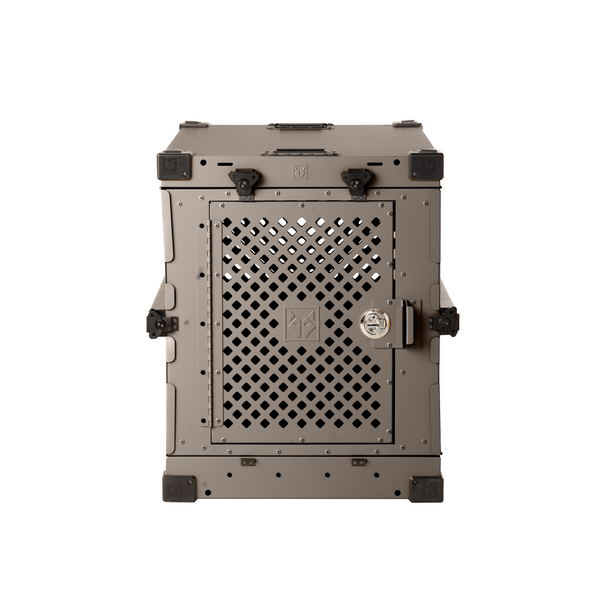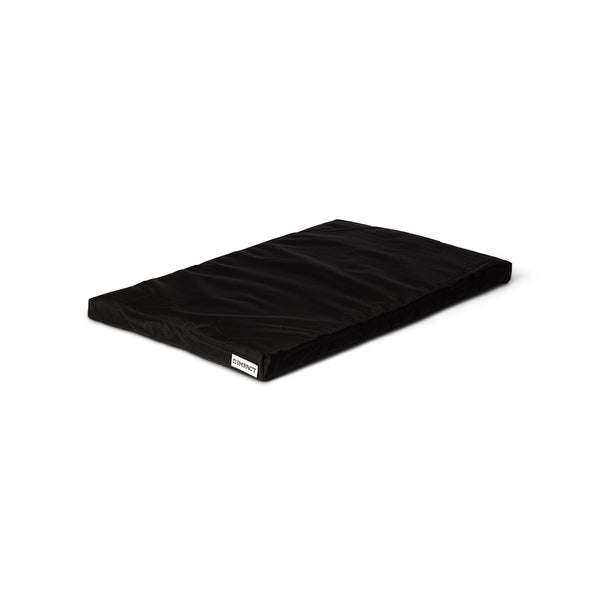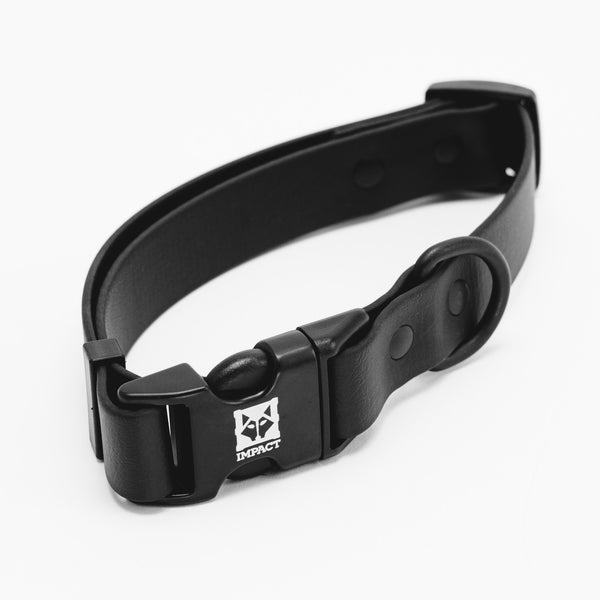If your dog is experiencing the issue of your dog peeing in their crate, it’s time for a change. This guide delivers clear guidance to identify the cause, whether it’s a training issue, separation anxiety, or a medical condition. Learn straightforward, tested methods to help your dog from going to the bathroom in their crate.
Key Takeaways
- Understanding your dog’s reason for peeing in the crate is crucial and can vary from lack of bladder control in puppies and older dogs, to separation anxiety, and even health concerns. Separation anxiety is a serious condition that many dogs suffer from, and you can learn more about the causes, symptoms, and treatments here.
- A comfortable crate environment is key—choose the right size crate for your dog, introduce them properly to make it a positive space, and remember that crate training is about creating a happy, secure resting place.
- Consistency and positive reinforcement in training are essential to prevent in-crate peeing—establish a routine, reward good potty habits, and manage accidents calmly with effective cleanup and patience.
Understanding Your Dog's Crate Peeing Behavior
When your furry friend leaves an unwanted “gift” in their crate, it’s a sign to pause and ponder what’s behind the behavior. From the developmental stages of young puppies to the emotional whirlwinds of anxious dogs, and even the possibility of underlying health issues, dog pees in the crate is a complex issue with a variety of triggers. One common reason is that they simply couldn’t hold it any longer and had to pee in their crate.
Let’s unravel these possibilities and set the stage for a dry, comfortable crate experience.
Unpacking Bladder Control in Puppies and Older Dogs
Puppies are synonymous with cuteness and… well, little bladder control. Their developing bodies mean that young puppies can’t always hold their urine through the night, leading to those dreaded damp mornings when puppy pees on the floor. Think of it this way: a one-month-old pup might only hold it for an hour, while a five-month-old has a bit more holding power. It’s a growing process, and understanding this will help pet parents foster patience rather than frustration after a few days of damp mornings using puppy pads.
On the other end of the spectrum, older dogs might face their own challenges. As they age, weakened bladder muscles can betray their best intentions, resulting in unexpected accidents and dog’s bladder control issues. It’s a natural part of the aging process, but it’s also a sign to give your senior companion the extra care they deserve.
The Anxiety Factor: When Emotions Lead to Accidents
Ever noticed your dog gets a bit panicky when you grab your keys? That’s separation anxiety rearing its head, and it’s a common culprit behind crate accidents. The symptoms can be loud and destructive, but sometimes they’re as quiet as a puddle in the corner of a crate. An overlong stay in the crate without breaks can stir up those anxious feelings, leading to those not-so-sweet surprises upon your return.
Enter the High Anxiety Dog Crate, a fortress of calm designed to soothe the frazzled nerves of our four-legged friends. With its tough-as-nails construction and snug ventilation holes, it’s a safe haven for the most anxious of pooches. Consider it a trusted ally in the battle against separation anxiety, with professionals around the globe giving it two thumbs up.
Health Concerns That Can Cause In-Crate Urination
Sometimes, the issue goes deeper than nerves or age. If your dog consistently soils their crate, it’s time to play detective and rule out any medical mischief. A trip to the vet can unveil problems like urinary tract infections, which can cause your pup to lose the bladder battles. Or perhaps a spinal cord injury is the unseen villain, reducing your dog’s ability to control their bathroom breaks.
Remember, senior dogs can fall prey to incontinence due to weakened bladder muscles, something a vet can spot with some bloodwork and a urine analysis. So, before you double down on training or switch up the crate size, make sure you’re not missing a health issue that’s crying out for attention.
Creating a Comfortable Crate Environment
A crate should be more than just a box—it should be a cozy den that your dog actually wants to spend time in. If your dog doesn't feel safe in their crate then it can cause them to develop an unhealthy relationship with their dog crate. This is why we strive to create the safest dog crates on the market that will help your dog feel safe. Check out our best selling dog crates:
Selecting the Perfect Crate Size for Your Dog
The Goldilocks rule of crate sizing is simple: not too big, not too small, just right. A crate that’s too roomy might tempt your pup to designate a bathroom corner far from their snoozing spot. But a space that’s too tight can cause anxiety and discomfort, which can also lead to accidents. For a growing puppy, consider an adjustable puppy’s crate with dividers that can expand as they do, ensuring comfort at every stage. And if you find that a wire crate seems to encourage your dog to treat it like a bathroom, a switch to a plastic construction might just do the trick.
For the big dogs in the house, a sturdy crate is a must. Think heavy-duty materials like aluminum that can handle the strength of a large breed while providing ample room to move around. It’s not just about size; it’s about finding a fit that makes your dog feel secure and serene.
Introducing Your Dog to the Crate Properly
Crate training is like a first date—you want to make a good impression. The goal is to make your dog fall in love with their crate, and that means making it a place of comfort, not confinement. Start by luring them in with high value treats or their favorite toy, rewarding them for just stepping a paw inside. It’s like saying, “Hey, this crate? It’s not so bad. Actually, it’s pretty great.”
Feeding your dog in their crate is another pro move. It creates a positive association with the space, building a connection in your dog’s mind between the crate and all the good things in life like food and, well, more food. With these tips, you’ll be on your way to creating a crate experience that’s less jail cell, more personal paradise.
Training Techniques to Prevent Peeing in the Crate
Let’s get down to brass tacks: preventing those crate accidents requires a game plan. With the right training techniques, you can guide your dog towards a pee-free crate experience. It’s about establishing routines, reinforcing positive behaviors, and being as patient as a saint.
Scheduling Success: Establishing a Potty Routine
Consistency is king when it comes to potty training. Here are some tips to help you create a predictable potty schedule for your puppy:
- Sync up with your puppy’s internal clock by taking them outside at the same times every day.
- Use meal times as a cue for potty breaks, as what goes in on schedule tends to come out on schedule.
- Take your puppy outside immediately after waking up, after playtime, and after meals.
- Reward your puppy with praise and treats when they go potty outside. By following these tips, you can make potty training easier and more successful for both you and your puppy.
Now, dogs are creatures of habit, but they’re not robots. Expect a learning curve, especially if you’re dealing with a young pup who can’t make it through the night just yet. If accidents are still happening, don’t be afraid to up the frequency of those bathroom trips. It’s all part of the dance, and soon enough, you’ll both be moving in step.
Positive Reinforcement: Rewarding Good Potty Habits
Nothing says “good job” like a tasty treat and a heartfelt “Who’s a good dog? You are!” Positive reinforcement is about celebrating the wins, no matter how small, and building a foundation of trust and good behavior. The moment your puppy does their business outside, shower them with treats and praise, making it a party they’ll want to attend again and again.
On the flip side, if your pup slips up and has an accident in the crate, resist the urge to scold. Negative reactions can lead to fear and anxiety, which can actually increase the likelihood of future accidents. Instead, keep it upbeat, clean up, and move on.
With a dash of patience and a sprinkle of positivity, you’re on your way to a well-trained, confident canine.
Managing and Cleaning After Accidents
Accidents happen—it’s a fact of doggy life. But how you handle the aftermath can make all the difference in your crate training journey. It’s about staying cool under pressure and turning a mess into a learning moment.
Effective Cleanup Strategies
When it comes to cleaning up after an accident, think like a crime scene investigator: it’s all about erasing the evidence. Enter pet odor removing spray, the unsung heroes that break down and eliminate the tell-tale odors that tempt your pooch to reoffend. By removing the scent markers, you’re sending a clear message to your dog: this crate is not a bathroom.
But it’s not just about the cleaners; it’s about the technique. Soak up the urine, apply the enzymatic cleaner, and let it work its magic. It’s a simple step that speaks volumes in the language of potty training, leading to a cleaner crate and a happier home.
Keeping Calm and Carrying On
Let’s face it: discovering a puddle in the crate can test the patience of a saint, especially when you’re experiencing difficulty controlling your emotions. But losing your cool can do more harm than good. Instead, take a deep breath and tackle the cleanup with a level head. Remember, your puppy is learning, and they need you to guide them with a gentle hand.
Once the crate is clean, it’s back to square one: reinforcing the right behaviors and patiently guiding your pup down the path to being house trained. Mistakes are part of the process, and with each cleanup, you’re one step closer to dry days and restful nights.
Additional Support and Resources
Sometimes, despite your best efforts, you hit a wall. And when that happens, it’s okay to call in reinforcements. Whether it’s diving into the wealth of information from the Association of Professional Dog Trainers (APDT) or considering crate training aids, there’s a world of support waiting for you.
When to Consult a Professional
If weeks have passed and your pup still seems more anxious in their crate than a cat at a dog park, it might be time to call in a pro. A Certified Professional Dog Trainer can offer tailored insights and strategies that go beyond the basics, addressing persistent behavioral issues with expert precision.
But it’s not just about fixing problems. Professional trainers can also help fine-tune your training techniques, making the whole process more enjoyable for both you and your furry friend. With the right guidance, you can turn crate training from a chore into a bonding experience.
Crate Training Aids and Accessories
Let’s jazz up that crate training routine with some snazzy accessories! The Impact Orthopedic Dog Bed is like the Rolls Royce of dog beds, offering a plush, supportive resting place that fits any crate. It’s a game-changer for making that crate the coziest spot in the house.
But why stop there? Fill a Kong with peanut butter or line the crate with a pee pad for those “just in case” moments. These little touches can make a big difference, transforming the crate from a lonely place to a personal haven.
Adapting Crate Training for Different Dog Breeds
Not all dogs are created equal, and that’s a beautiful thing. From the tiny Chihuahua to the towering Great Dane, each breed comes with its own crate training quirks and considerations as dogs learn.
Tailoring Training for Small Dogs
For the little guys, crate training is all about recognizing their unique needs. Here are some tips:
- Adjust your schedule for more frequent potty breaks due to smaller bladders.
- Be patient and give them time to adjust to the crate.
- Use a crate that feels safe and secure without being overwhelming in size.
Remember, small dogs can have big personalities, and they need a training approach that’s just as dynamic. Keep things interesting with a variety of treats and toys, and you’ll have a pint-sized potty expert in no time. With the right guidance, it’s possible to potty train your small dog effectively.
Considerations for Large Dog Breeds
For the big breeds, it’s a different story. Their larger size means a bigger crate is a must, giving them enough room to stretch out and relax without feeling cramped. And because they can hold their bladder for longer, you might find they’re ready for more freedom in the house sooner than their smaller counterparts.
But don’t let their size fool you—large dogs still crave comfort and security. Many owners of large or extra-large dog breeds struggle to find secure crates that are large enough to fit their giant dogs. Fortunately, Impact Dog Crates offers various crate sizes and models that are specifically designed to protect large dog breeds (even Great Danes). Ensure their crate is a castle fit for a canine king or queen, and they’ll be just as happy to hang out there as any lapdog.






